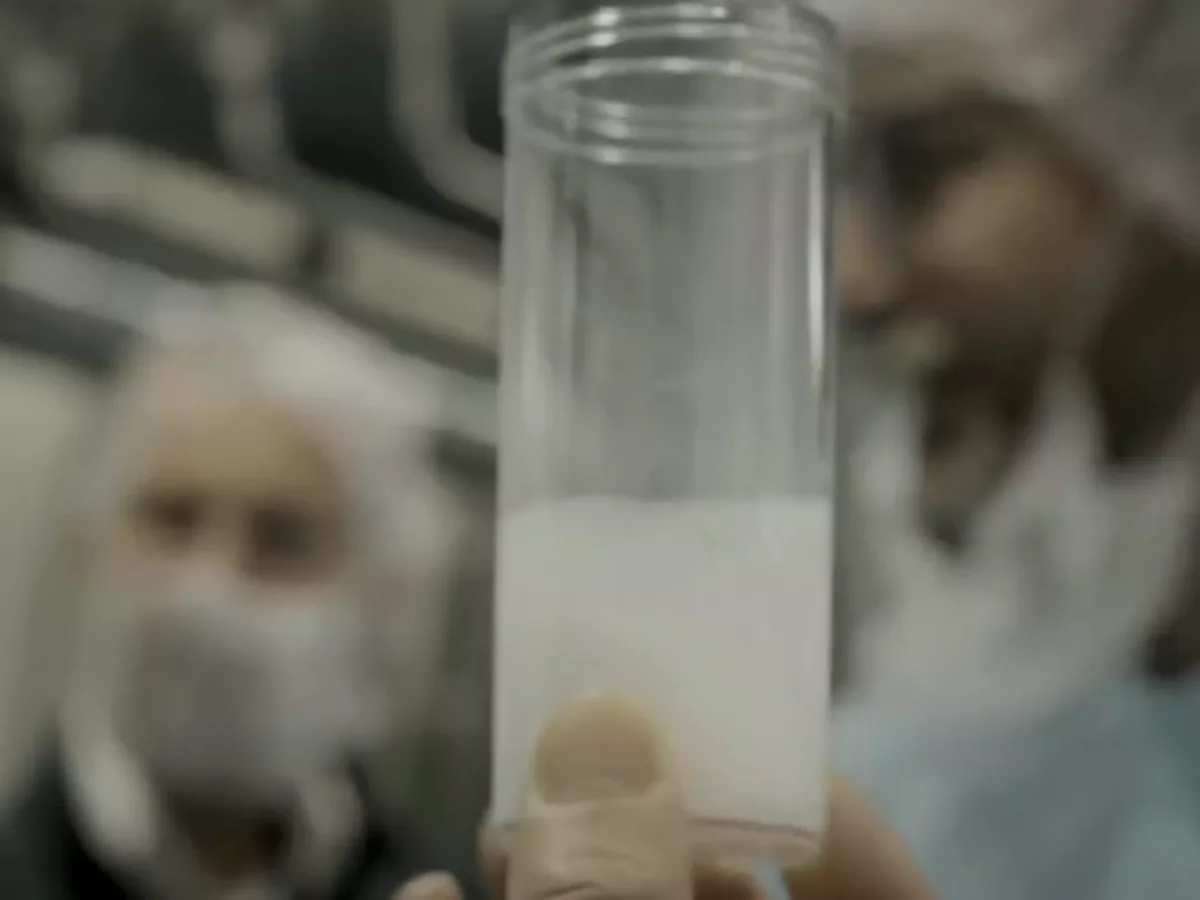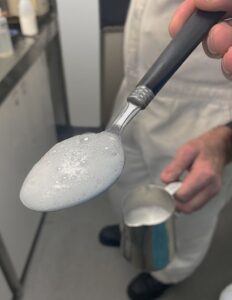Don’t have a cow: the Australian startup brewing high-tech animal-free milk

Eden Brew is roughly 18 months old and commercialising CSIRO R&D on precision fermentation for animal-free milk, which it says has a “four-casein micelle” identical to dairy milk. It recently announced it raised $US 5 million to support commercialisation, and is preparing to launch ice cream from this in time for summer next year. We spoke to CEO Jim Fader following the announcement, about feedstocks, protein shortages and more.
@AuManufacturing: Is the way you’re creating milk a first?
Jim Fader: The micelle creation from recombinant proteins we believe is world-first. We’ve got a patent application in now for that.
@AuManufacturing: Can you give a rough description about how it works, in terms of feedstocks and yeasts and the rest of it?
Jim Fader: I would say it’s a pretty standard precision fermentation process. It is a fairly widely-adopted technology now. It’s been used, for example, to make human insulin instead of harvesting it from animals, and it’s been made to make a product called chymosin, which is I guess a synthetic rennet that you would eat in your cheese. That’s been done since about the 80s, where rennet also has been harvested from the stomachs of baby animals. So it’s actually a well-tried manufacturing technology.
The feedstocks can be quite varied, mostly sugar based, and we are still playing around with which feedstock we prefer the most, but it’ll be some type of sugar that goes in and we take a yeast and we create a DNA identical to that of the animal. We create a synthetic DNA. We don’t even biopsy the animals for DNA. And there’s some genetic modification, if you like, and we put that DNA inside the yeast cell and then you set up the fermentation environment and you feed it a type of sugar, and then the fermentation process does the rest. And the cells will express out of the cell – into the broader fermentation environment – the dairy proteins. So we’ve done this work to get an expression system up, individually, one for each of six different proteins that we’re making. So it’s hard work to get that done so that the protein is being expressed to a nature-identical manner. And we’ve achieved that. And now what we’re doing is turning the turbocharger up, if you like. Trying to get the brew time as short as possible and trying to get the amount of protein – they call it the titre – the amount of protein that’s expressed up as high as possible. And the more those science KPIs or fermentation KPIs improve, the lower the costs of the exercise. So we call that industrialising the science and getting the costs to the point that we can make a product at a cost consumers are willing to pay.

An early prototype (image credit CSIRO)
The other real significant challenge is once you’ve done the fermentation, you’ve got to purify the protein out of the ferment and you’ve got to do it accurately so that you don’t throw away a lot of your target protein, but also you don’t capture stuff you don’t want. And so we’re perfecting that. And actually, that’s where we’re finding beer brewers’ skill sets quite interesting, because they use yeast to make beer. We’re using yeast to make proteins to make another product, so they really understand and have IP in this kind of purification step, which we’re accessing and leveraging. I expect we will be partnering with large breweries as part of our fermentation capacity solution. And we’re also doing some feasibility and research with the wine industry on how their fermentation capacity that largely sits idle for at least six months of the year can also be utilised. So we’re quite excited by that. And the main wine players seem very open minded. So we’re doing a little bit of research around how could that work.
That’s kind of the first half of the production: brew, purify really accurately, then we turn each of those proteins individually into a powder which has got about a two year life. And then we’re going to ship those powders to Norco dairies who are co-founding the company with us. They’re going to receive those powders, rehydrate them and turn them into a liquid. We’ve got a bit of a proprietary process there, where those four caseins get mixed and that micelle gets created and then they throw in the other ingredients. And at that point, you can consider it like raw milk from a dairy. So they will then just put it down there, homogenise it, pasteurise it and bottle it like real milk, and you get a refrigerated bottle of animal-free milk at the other side.
@AuManufacturing: How big is a batch and how long does it take? And how long does it have to take to be commercially appealing?
Jim Fader: We’re planning around anywhere from 2 to 1,000 litres at the moment. And the brew time is 96 hours. don’t think we will shorten the brew time too much from that. And we’re using the 1,000-litre fermenter to make raw material, raw protein that we’re going to send to Norco to turn into ice cream in the next couple of months to kind of validate our ice cream production process. The next step for us really is to repeat this exercise in a tank around about 15,000 litres. It does two things: firstly, if you can control something at around about 3000 litres, you can control it at about 150,000 litres. We’ll play around a 50 knowing it’s well on the way to 150,000 litres. And each tank that we brew in really will be will be at that scale of 150,000 litres because of the operational efficiencies of brewing at that scale. That’s the first reason is scale to control the parameters at scale. The second one is techno economics. Being able to demonstrate that we really understand the costs when brewing it at that kind of mid-scale shows that we’ve really got a handle on what we believe the costs can be managed to when we’re at 150,000 litres. And that’s really important, because we’ve got we’ve got techno economic models which say depending on how quickly we improve our science KPIs and how quickly we get to large-scale fermenting on one axis and on the other axis, you put dairy inflation, which could be 5 per cent or as much as 20 per cent. There’s the rising costs of dairy. We’re kind of anticipate that we would be line priced with milk around 2030.
@AuManufacturing: I read that there was an issue with producing a brilliant white colour. What’s that a result of and how addressable is it?

Jim Fader (image credit Eden Brew)
Jim Fader: Milk gets this white colour because the calcium binds to the micelle. And so when milk comes from an animal, there are other things in there which detract from the absolute whiteness of the calcium that you’re seeing. And we’ve an aseptic and very, very clean environment in a fermenter, a bit like an operating theatre. And so we have made a very, very white milk. And when you look at it on its own, you think, ‘oh, it’s milk’ and you taste it ‘oh its milk.’ But then when you’re side by side with, say, Norco’s branded milk, it’s more white than that. That’s very addressable by using things like beta carotene. Or we’ll find natural ingredients that just pull it back from being so white.”
@AuManufacturing: There’s a sort of language policing issue with alternative proteins that you sometimes see. As a personal point of view, I think it’s silly. Do you have a point of view on what defines milk? Is what you’re making milk, and should people care?
Jim Fader: It’s a really interesting space. I’m all for transparency with the customer and all for choice for the customer. My history is in product development, inside supermarket retail supply chains. And so I spent my entire life trying to work out what the customers want and where are there gaps in retail offers and how can we invent products that meet their needs and jump on the consumer trends that we’re seeing? And I see that this is really no different. It’s also driven, though, by a mandate. And that mandate is that through diet change and and therefore consumer trends, and population growth, the demand for protein is going to grow by at least 50 per cent over the next 30 years, and 30 years is no time for industry-level change.
So we’re in – I don’t want to use the word crisis, but we’re in a very strong challenge to meet demand for protein in a sustainable way to feed our population now, let alone in 30 years time when you’ve got to have a structurally larger demand on the existing food supply chain. So I think that customers are going to drive the need for these products. And I think money is flowing into science because the science is there and the products can be made. And we’re kind of riding the early parts of the wave with so much more of this technology will become very mainstream and very accepted. There will be early adopters and there’ll be those that are rusted on to the old way, and you get that with any kind of innovation as it reaches tipping points. But I am very confident that food made this way will be very normal in the next ten or 20 years across all categories.
So getting back then to the definition of milk, it’s lactated from a mammalian cell. So as our product is not lactated from a mammalian cell, even though we’re identical, we can’t call ourselves milk and be transparent to the consumer in the eyes of the law. So it would be our approach to call ourselves animal-free milk because that clearly passes ourselves off as different to dairy milk. And just like shortbread is not bread and ginger beer is not beer, animal-free milk is not dairy milk. And so we will, for the first part, do exactly what Food Standards Australia New Zealand tell us we should do. But then I’m really in favour of the industry working together to make sure that we self-regulate and we ensure that we stay very transparent to the consumer and we give them choice.
@AuManufacturing: What’s ahead of you for approvals to sell your milk? Is it particularly difficult for fermented products?
Jim Fader: There’s a handbook published by FSANZ that we all use as a guideline that talks about novel foods or genetically-modified foods and how to get them approved for sale. That’s publicly available on their website and is what we’re working off. And we see it as a very onerous and thorough process. I’m quite happy that it is, to be honest, because they are the gatekeepers of what’s approved for food. And it’s about a 12 month process to get an approval, but you need to be almost manufacturing-ready to have all the answers for FSANZ because they not only want to know what’s in it, but they want to know how it’s made, where it’s made, everything that’s in the production environment. They really want to know everything. We’ve had a number of conversations with them.
The principles are the same as if you wanted a DA for your house. If you just rock up to the council and say, ‘here are my plans.’ They might say ‘wait a minute.’ But if you say, ‘Hey, I’m thinking of designing a house’ and you take them on the journey with you, then I think the actual application process runs more smoothly. So we’ve engaged FSANZ. They know everything in this space. They are really well-educated. They’re also quite proactive and they’ve approved products in this space already. For example The Impossible Burger has got heme inside it, which is made through precision fermentation. And so they are well-educated, they’ve gone through the approvals process and they see that this is a sign of a lot more to come. So they’re working hard to make sure that their frameworks and processes keep pace with the manufacturing technologies.
This interview has been lightly edited for clarity.
Main image credit: Eden Brew
Subscribe to our free @AuManufacturing newsletter here.
Topics Manufacturing News Technology
@aumanufacturing Sections
Analysis and Commentary Awards Defence Manufacturing News Podcast Technology Videos






